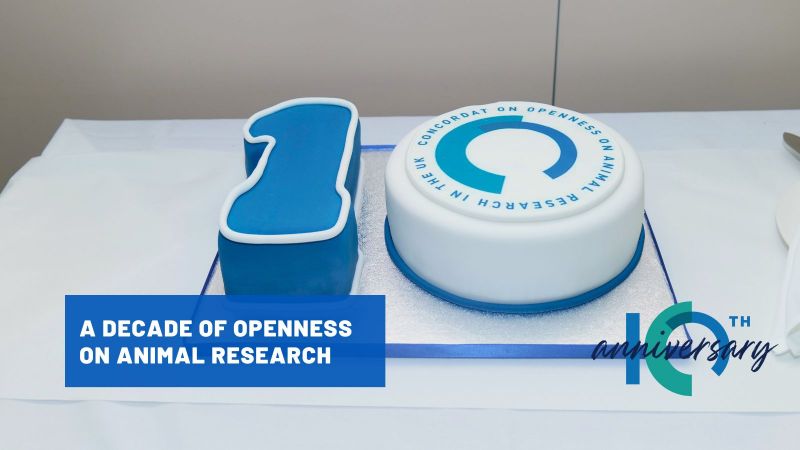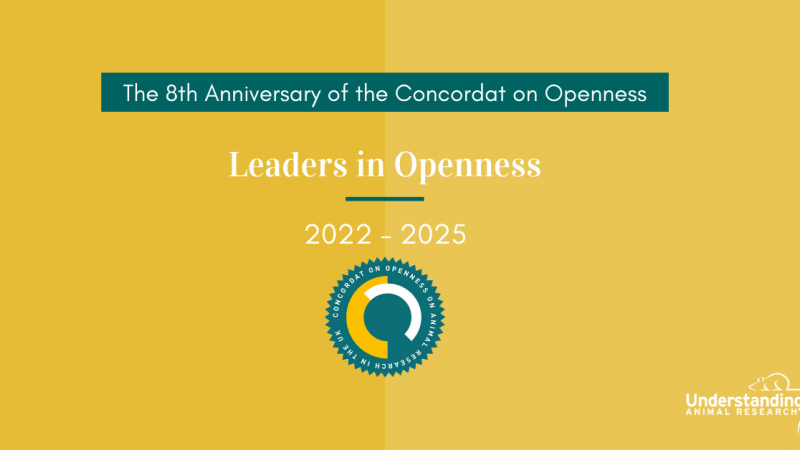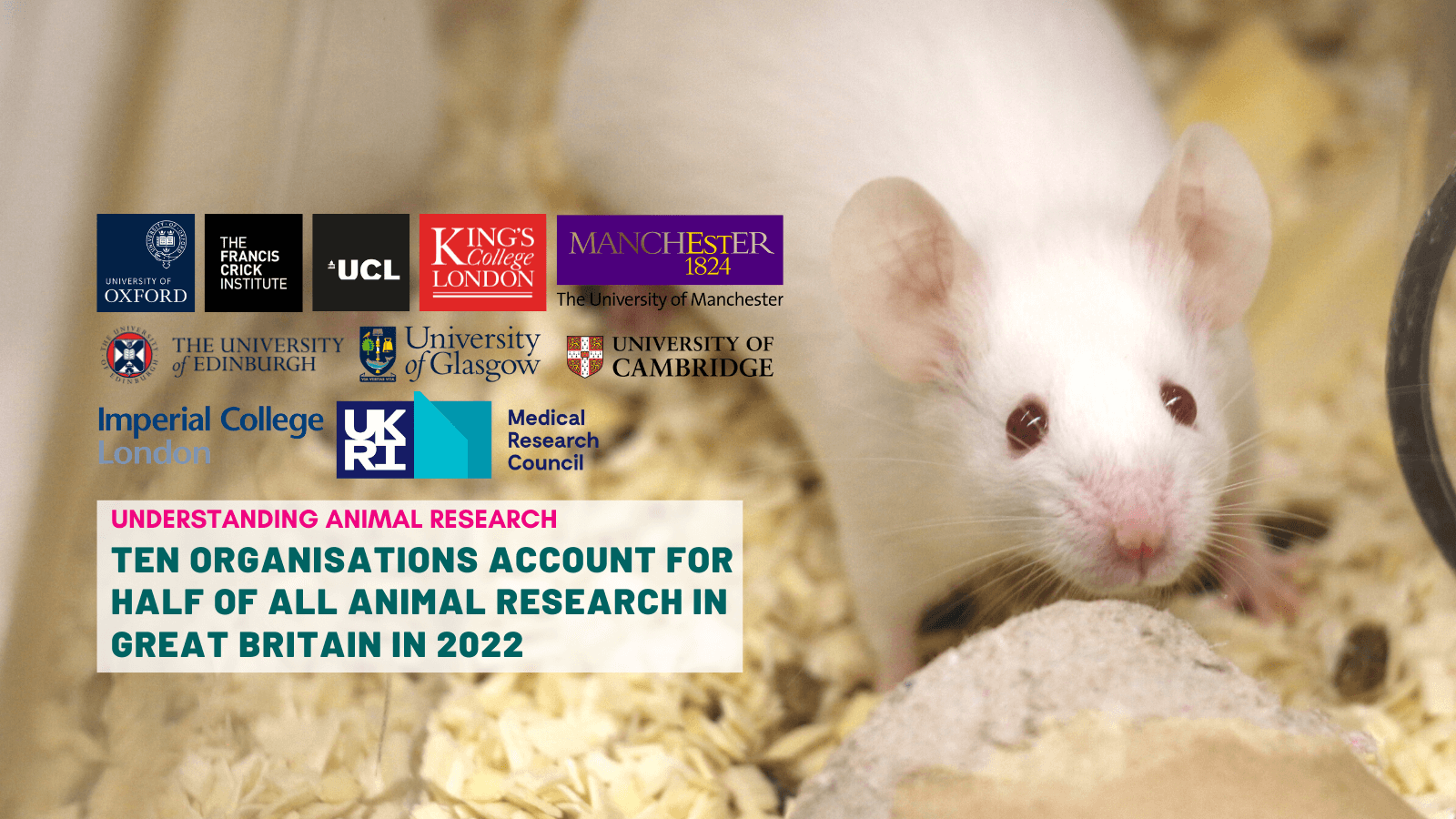
Ten organisations account for half of all animal research in Great Britain in 2022
-
99% of procedures carried out in mice, fish, and rats
-
82% of procedures caused pain equivalent to, or less than, an injection
-
64 research institutions proactively share their 2022 animal research statistics
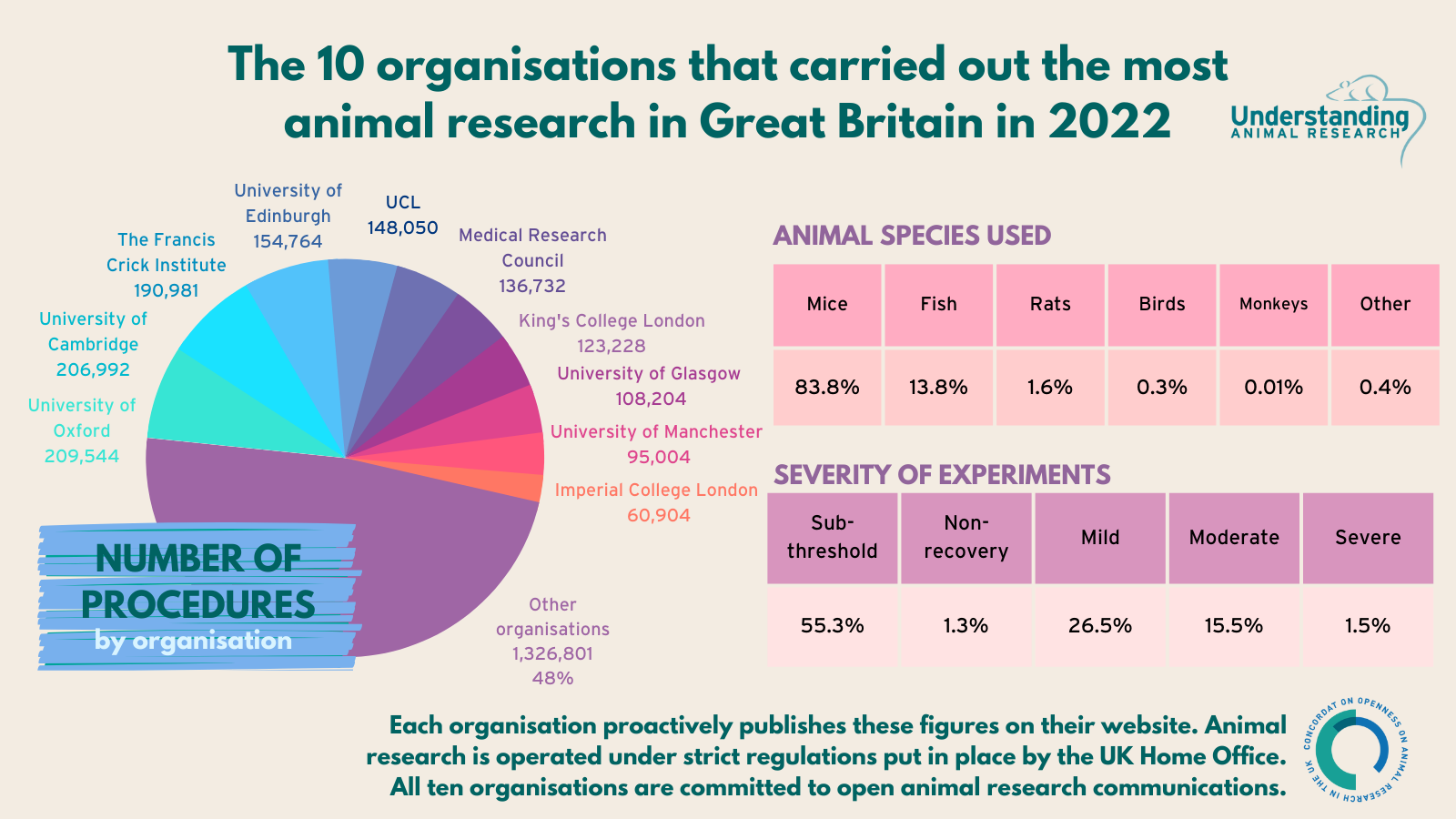
Today, 13 July 2023, Understanding Animal Research (UAR) has published a list of the ten organisations that carry out the highest number of animal procedures – those used in medical, veterinary, and scientific research – in Great Britain. These statistics are freely available on the organisations’ websites as part of their ongoing commitment to transparency and openness around the use of animals in research.
This list coincides with the publication of the Home Office’s report on the statistics of scientific procedures on living animals in Great Britain in 2022.
These ten organisations carried out 1,434,403 procedures, 52% or just over half of the 2,761,204 procedures carried out on animals for scientific research in Great Britain in 2022. Of these 1,434,403 procedures, more than 99% were carried out on mice, fish and rats and 82% were classified as causing pain equivalent to, or less than, an injection.
For more information on the 2022 animal research statistics for Great Britain, you can read our analysis.
The ten organisations are listed below alongside the total number of procedures they carried out in 2022. Each organisation’s name links to its animal research webpage, which includes more detailed statistics. Case studies explaining how animal research has been used in recent medical research are also provided in the Notes to Editors section. This is the eighth consecutive year that organisations have come together to publicise their collective statistics and examples of their research.
|
Organisation |
Number of Procedures (2022) |
|
209,544 |
|
|
206,992 |
|
|
190,981 |
|
|
154,764 |
|
|
148,050 |
|
|
136,732 |
|
|
123,228 |
|
|
108,204 |
|
|
95,004 |
|
|
60,904 |
|
|
TOTAL |
1,434,403 |
64 organisations have published their 2022 animal research statistics
UAR has also produced a list (see appendix) of 64 organisations in the UK that have publicly shared their 2022 animal research statistics. This includes organisations that carry out and/or fund animal research.
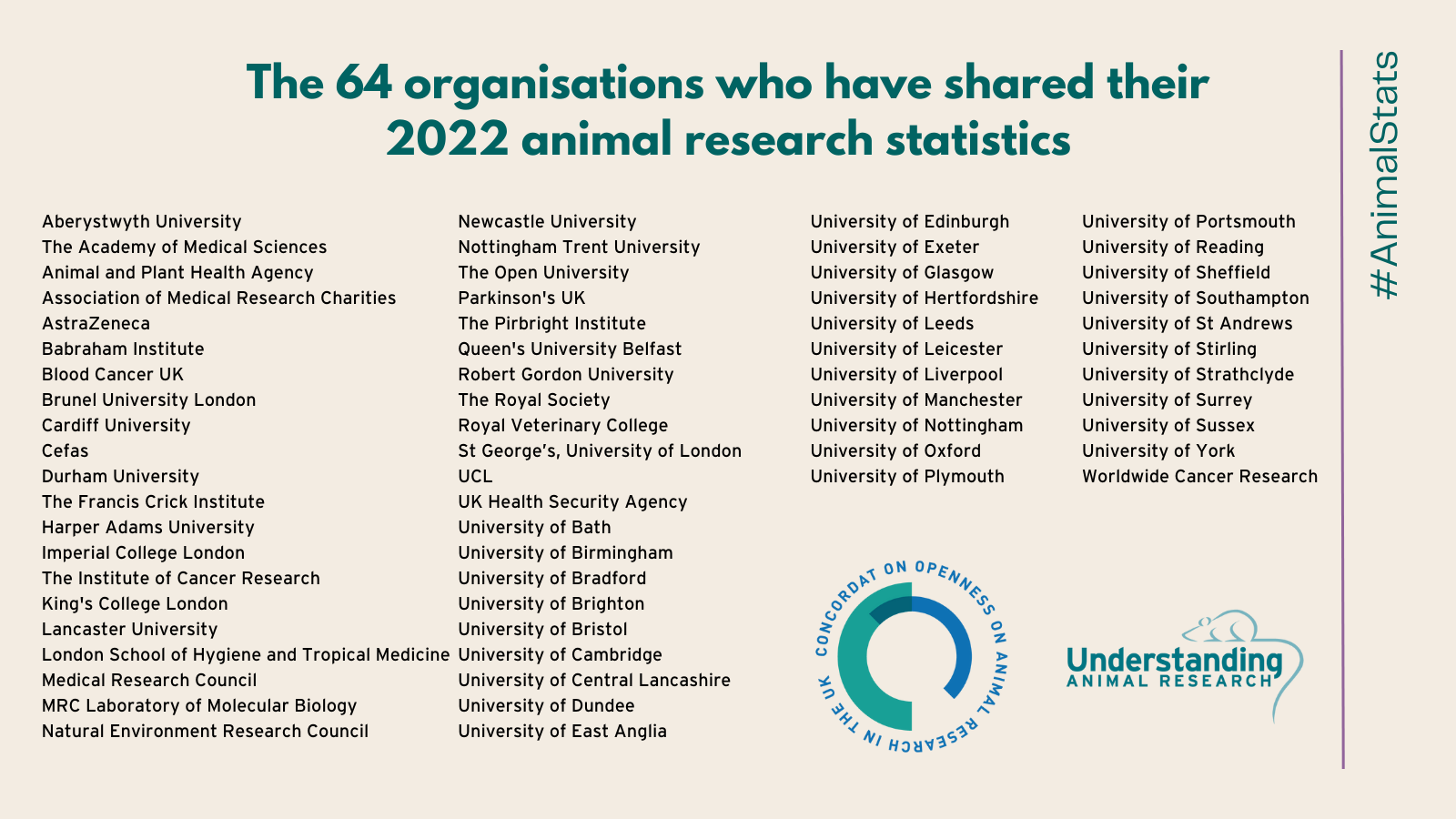
All organisations are committed to the ethical framework called the ‘3Rs’ of replacement, reduction and refinement. This means avoiding or replacing the use of animals where possible, minimising the number of animals used per experiment and optimising the experience of the animals to improve animal welfare. However, as institutions expand and conduct more research, the total number of animals used can rise even if fewer animals are used per study.
All organisations listed are signatories to the Concordat on Openness on Animal Research in the UK, which commits them to be more open about the use of animals in scientific, medical and veterinary research in the UK. More than 125 organisations have signed the Concordat including UK universities, medical research charities, research funders, learned societies and commercial research organisations.
Wendy Jarrett, Chief Executive of Understanding Animal Research, which developed the Concordat on Openness, said:
“Animal research remains a small but vital part of the quest for new medicines, vaccines and treatments for humans and animals. Alternative methods are gradually being phased in, but, until we have sufficient reliable alternatives available, it is important that organisations that use animals in research maintain the public’s trust in them. By providing this level of information about the numbers of animals used, and the experience of those animals, as well as details of the medical breakthroughs that derive from this research, these Concordat signatories are helping the public to make up their own minds about how they feel about the use of animals in scientific research in Great Britain.”
Professor Anne C Ferguson-Smith, Pro-Vice-Chancellor (Research & International Partnerships) and Arthur Balfour Professor of Genetics, University of Cambridge, said:
“In Cambridge we have careful monitoring of our animal usage, applying reduction, replacement and refinement of animal work to ensure that they are only used when there is no alternative. For example, animals are used in research tackling neurodegenerative diseases like Parkinson’s and Multiple Sclerosis, and in repairing damaged nerves to restore movement to paralysed limbs. We want to make major improvements to people’s lives, and we have a moral responsibility to ensure new treatments or procedures are safe, by assessing them first on animals, before developing approaches to apply them to humans.”
Dimitrios Anastasiou, Senior Group Leader, and Chair of the Crick’s 3Rs Committee, said:
“We want to understand more about how living things work to help improve treatment, diagnosis, and prevention of human disease. The Crick research infrastructure offers easy access to a range of non-animal methodologies. However, animals are still needed to provide insights into how complex organisms work and what goes wrong in disease. If we use animals, we do so with the least number of animals, while ensuring the most optimal conditions to minimise the impact on animal welfare.”
Dr Catherine Martin, Vice-Principal Corporate Services, University of Edinburgh, said:
“The University of Edinburgh uses animals in research only when their use is justified on scientific, ethical and legal grounds and when no suitable alternatives are available. We demonstrate our commitment to the 3Rs – Replacement, Reduction and Refinement – in numerous ways, including the development and use of non-animal models, such as in vitro methods, computer modelling and human subjects, where appropriate. We will keep working on the implementation of these principles across the University of Edinburgh to address scientific challenges while continuing to strive to reduce the numbers of procedures carried out in animals.”
Professor Geraint Rees, UCL Vice-Provost (Research, Innovation & Global Engagement) said:
“Animal research forms a small but vital part of biomedical research at UCL, contributing to life-saving medical advances from cancer to dementia to Covid-19 and beyond. Our scientists use animals in their research only when necessary, while continually striving to develop new ways to replace animals in their research, reduce their usage, or refine their methods to mitigate harm, without detracting from the quality and potential impact of the research.”
Claire Newland, MRC Director of Policy, Ethics and Governance, said:
“The MRC, part of UKRI, supports the highest quality research that has led to the development of life-saving treatments and advanced our understanding of basic human biology. The use of animals has been necessary for many of these developments, including recent breakthroughs in our understanding of metabolism-associated diseases.
MRC-funded research has the highest possible level of animal welfare and is guided by the principles of replacing, refining and reducing the use of animals, MRC upholds the commitments of the recently published UKRI position statement on involving animals in research and innovation.”
Dr Julie Keeble, Interim Director of Biological Services at King’s College London, said:
“At King's we are committed to enabling world class research that puts animal welfare first. Research on animals is only carried out where there are no alternatives and where an integrated whole-body system is required to advance research.”
David Duncan, University of Glasgow Deputy Vice-Chancellor and Chief Operating Officer, said:
“Research using animals makes a vital contribution to the understanding, treatment and cure of a range of major diseases and viruses in humans such as cancer, Alzheimer’s and COVID-19. While the University is committed to the development of alternative methods – such as computer modelling, tissue culture, cell and molecular biology, and research with human material – some work involving animals must continue for further advances in medical sciences to be made. Animals are used in research only where it is essential, and the University remains committed to the principles of reduction, refinement, and replacement. All research undertaken on animals is conducted under strict ethical and welfare guidelines, under licence by the Home Office.”
Dr Joanna Stanley, Named Training and Competency Officer and 3Rs manager at The Biological Services Facility, University of Manchester, said:
“At the University of Manchester, we ardently advocate for the 3Rs – Replacement, Reduction, and Refinement of animal usage in research. The 3Rs are ingrained in all aspects of our work, from striving to replace animals in research procedures whenever feasible, to implementing the most up-to-date refinements in our housing and husbandry practices. We are deeply committed to this approach, as it allows us to conduct the most pertinent and reproducible research while maintaining the highest standards of animal welfare.”
Professor Marina Botto, Director of Bioservices, Imperial College London, said:
“Imperial continues its commitment towards the 3Rs principles and openness around animal research. At Imperial animals are used only when there is no other viable alternative to understand human diseases and how they can be treated. Imperial is committed to the highest standards of animal welfare and this is reflected in our accreditation by AAALAC International, which promotes the humane treatment of animals in science.”
-Ends-
Notes to Editors
The hashtag for social media is #AnimalStats.
Understanding Animal Research (UAR) is a not-for-profit organisation that explains how and why animals are used in scientific research in the UK. UAR promotes open communications about animal research.
A list of recent animal research case studies from contributing organisations can be found below.
Further information on the Concordat on Openness on Animal Research in the UK can be found here: http://concordatopenness.org.uk
These figures refer to procedures using animals for medical, veterinary, or scientific research, as licensed by the UK’s Home Office under the Animals (Scientific Procedures) Act 1986. The use of animals to test tobacco products was banned in the UK in 1997 and it has been illegal to use animals to test cosmetic products in this country since 1998. A policy ban on household product testing using animals was introduced in 2010. Since 2013, it has been illegal to sell or import cosmetics anywhere in the UK or the EU where the finished product or its ingredients have been tested on animals.
*The Home Office recorded 2,761,204 completed procedures in 2022, 1,434,403 (52%) of which were carried out at these ten organisations.
Full table of procedures broken down by species from top ten organisations:
|
Organisation |
Total Procedures (2022) |
Mice |
Fish |
Rats |
Birds |
Non-Human Primates |
Other animals |
|
209,544 |
200,720 |
7,776 |
838 |
63 |
3 |
144 |
|
|
206,992 |
162,724 |
39,006 |
4,406 |
2 |
68 |
786 |
|
|
190,981 |
172,997 |
17,633 |
|
|
|
351 |
|
|
154,764 |
97,740 |
43,219 |
8,901 |
3,689 |
|
1,215 |
|
|
148,050 |
96,502 |
48,721 |
2,298 |
|
|
529 |
|
|
136,732 |
136,673 |
|
6 |
|
53 |
|
|
|
123,228 |
98,073 |
23,092 |
1,885 |
|
|
178 |
|
|
108,204 |
102,685 |
3,059 |
1,119 |
680 |
|
661 |
|
|
95,004 |
77,979 |
13,439 |
2,668 |
|
|
918 |
|
|
60,904 |
56,497 |
2,302 |
1,155 |
196 |
|
754 |
|
|
TOTAL |
1,434,403 |
1,202,590 (83.8%) |
198,5247 (13.8%) |
23,276 (1.6%) |
4,630 (0.3%) |
124 (0.01%) |
5,536 (0.4%) |
All numbers represent completed procedures on animals in 2022. The number of procedures carried out using animals will be slightly higher than the number of animals used, as a small number of animals may be used in more than one procedure.
Full table of procedures broken down by severity categories from top ten organisations:
|
Organisation |
Sub-Threshold |
Non-Recovery |
Mild |
Moderate |
Severe |
Total Procedures (2022) |
|
138,010 |
1,929 |
31,317 |
35,614 |
2,674 |
209,544 |
|
|
83,670 |
1,557 |
84,742 |
34,901 |
2,122 |
206,992 |
|
|
140,602 |
835 |
26,542 |
21,810 |
1,192 |
190,981 |
|
|
98,006 |
1,767 |
32,820 |
19,830 |
2,341 |
154,764 |
|
|
52,795 |
5,404 |
63,350 |
26,050 |
451 |
148,050 |
|
|
87,558 |
1,620 |
35,711 |
7,050 |
4,793 |
136,732 |
|
|
50,022 |
2,354 |
45,930 |
20,087 |
4,835 |
123,228 |
|
|
68,619 |
790 |
16,289 |
21,131 |
1,375 |
108,204 |
|
|
56,065 |
629 |
18,283 |
19,398 |
629 |
95,004 |
|
|
17,751 |
1,253 |
25,453 |
15,852 |
595 |
71,406 |
|
|
TOTAL |
793,098 (55.3%) |
18,138 (1.3%) |
380,437 (26.5%) |
221,723 (15.5%) |
21,007 (1.5%) |
1,434,403 |
Examples of severity
Severity assessments measure the harm experienced by an animal during a procedure. A procedure can be as mild as an injection, or as severe as an organ transplant. Severity assessments reflect the peak severity of the entire procedure and are classified into five different categories:
Sub-threshold: When a procedure did not cause suffering above the threshold for regulation, i.e. it was less than the level of pain, suffering, distress or lasting harm that is caused by inserting a hypodermic needle according to good veterinary practice.
Non-recovery: When the entire procedure takes place under general anaesthetic and the animal is humanely killed before waking up.
Mild: Any pain or suffering experienced was only slight or transitory and minor so that the animal returns to its normal state within a short period of time. For example, the equivalent of an injection or having a blood sample taken.
Moderate: The procedure caused a significant and easily detectable disturbance to an animal’s normal state, but this was not life-threatening. For example, surgery carried out under general anaesthesia followed by painkillers during recovery.
Severe: The procedure caused a major departure from the animal’s usual state of health and well-being. This would usually include long-term disease processes where assistance with normal activities such as feeding and drinking were required, or where significant deficits in behaviours/activities persist. Animals found dead are commonly classified as severe as pre-mortality suffering often cannot be assessed.
List of 64 UK organisations that have shared their 2022 animal research statistics:
Aberystwyth University
The Academy of Medical Sciences
Animal and Plant Health Agency
Association of Medical Research Charities
AstraZeneca
Babraham Institute
Blood Cancer UK
Brunel University London
Cardiff University
Cefas
Durham University
The Francis Crick Institute
Harper Adams University
Imperial College London
The Institute of Cancer Research
King's College London
Lancaster University
London School of Hygiene and Tropical Medicine
Medical Research Council
MRC Laboratory of Molecular Biology
Natural Environment Research Council
Newcastle University
Nottingham Trent University
The Open University
Parkinson’s UK
The Pirbright Institute
Queen's University Belfast
Robert Gordon University
The Royal Society
Royal Veterinary College
St George’s, University of London
UCL
UK Health Security Agency
University of Bath
University of Birmingham
University of Bradford
University of Brighton
University of Bristol
University of Cambridge
University of Central Lancashire
University of Dundee
University of East Anglia
University of Edinburgh
University of Exeter
University of Glasgow
University of Hertfordshire
University of Leeds
University of Leicester
University of Liverpool
University of Manchester
University of Nottingham
University of Oxford
University of Plymouth
University of Portsmouth
University of Reading
University of Sheffield
University of Southampton
University of St Andrews
University of Stirling
University of Strathclyde
University of Surrey
University of Sussex
University of York
Worldwide Cancer Research
CASE STUDIES
University of Oxford
Deep brain stimulation to treat Parkinson's
Deep brain stimulation, where electrical pulses are delivered to specific structures deep in the brain, is an effective treatment for Parkinson’s disease. Improving the treatment requires the ability to test new ways of stimulating, but this is difficult to achieve using people with Parkinson's disease, as it requires considerable resources. One candidate for improving deep brain stimulation is to use a "closed-loop" approach, whereby brain signals are recorded and analysed in real-time for activity that is known to be a marker of disease symptoms. Stimulation pulses can then be timed to coincide with these activities in order to reduce both symptoms and side effects. We used a well-established rodent model of Parkinson's disease to examine a closed-loop approach that was applied using a microchip that could also be used in human stimulation devices. Using these experiments, we were able to demonstrate that our approach could reduce activity associated with Parkinsonian symptoms and change the movement of the rats in predictable ways. This work provides important evidence that closed-loop stimulation could be an impactful technique in human deep brain stimulation and that it can be implemented using technology suitable for human devices.
University of Cambridge
The Ugly Naked Guys who age healthily, don’t feel pain, and rarely get cancer
“Naked mole-rats have many weird features, and we’re trying to work out the underpinning genetic or physiological basis for these. That knowledge could be used to help companion animals or humans with problems such as inflammatory pain, arthritis and cancer.”
Professor Ewan St. John Smith, University of Cambridge Department of Pharmacology
A team at Cambridge has revealed that naked mole-rats have a genetic variation that makes acid act as an anaesthetic to their nerves. Understanding this better could help develop new pain-relieving drugs for human inflammatory conditions lsuch as arthritis.
The animals have exceptional cancer resistance compared to humans. The team found that mutations in naked mole-rat DNA occur at a slower rate than in mouse DNA, and suggest that naked mole-rats have an ultra-good immune system that spots and kills cancer cells.
Naked mole-rats live for over 30 years and age healthily. The team is also investigating how the animal’s brain changes with age, offering potential clues for healthy aging and age-related illnesses like dementia.
University of Cambridge - Weird naked mole rats
The Francis Crick Institute
Understanding the link between air pollution and cancer
An example of Crick research where work on mice was essential to major new biomedical insights was the discovery of how air pollution can cause lung cancer in people who have never smoked. The Crick team observed how PM2.5, tiny particles around 3% of the width of a human hair, can cause inflammation. The inflammation can then go on to wake up normally inactive cells in the lungs which carry cancer-causing mutations, triggering these cells to grow uncontrollably and form tumours.
University of Edinburgh
Drug shows promise for motor neuron disease
A drug typically used to treat enlarged prostates and high blood pressure has shown promise as a potential new therapy for motor neuron disease (MND), according to a study involving zebrafish and mice models.
Experts from the University of Edinburgh demonstrated that the drug terazosin protects against the death of motor neurons by increasing their energy production.
Researchers say the drug could help to slow the progression of MND, which destroys nerve cells known as motor neurons, causing patients to slowly lose function of their muscles.
It is still unclear why motor neurons die, but experts know that a decrease in their energy production takes place at an early stage of the disease.
Researchers targeted the energy production of motor neurons as a potential therapeutic strategy for treating MND.
Using terazosin, which has been shown to be effective at increasing energy production in models of other diseases, the team wanted to determine if this drug could also protect motor neurons from MND. They focused on an enzyme involved in energy production called PGK1.
Zebrafish models of MND showed that either genetically increasing the amount of PGK1 in the zebrafish or treating them with terazosin to increase PGK1’s activity improved the growth of motor neurons.
Terazosin also protected motor neurons in a mouse model of MND, improving survival and delaying the progression of paralysis.
The team also grew motor neurons in a dish and demonstrated that terazosin protects these cells by increasing energy levels.
Researchers are starting a feasibility study into the drug’s effect in MND patients. If this proves successful, they will look to launch a full clinical trial.
University of Edinburgh - MND Terazosin
UCL
Magnetic seeds used to heat and kill cancer
Scientists at UCL have developed a novel cancer therapy, now demonstrated in mice, that uses an MRI scanner to guide a magnetic seed through the brain to heat and destroy tumours.
The therapy is called “minimally invasive image-guided ablation” or MINIMA and comprises a ferromagnetic thermoseed navigated to a tumour using magnetic propulsion gradients generated by an MRI scanner, before being remotely heated to kill nearby cancer cells.
Researchers say the findings, published in Advanced Science, establish ‘proof-of-concept’ for precise and effective treatment of hard-to-reach glioblastoma, along with other cancers such as prostate, that could benefit from less invasive therapies. They say the therapy has the potential to extend survival, reduce recovery times, and to avoid traditional side effects by precisely treating the tumour without harming healthy tissues. Because the heating seed is magnetic, the magnetic fields in the MRI scanner can be used to remotely steer the seed through tissue to the tumour. Once at the tumour, the seed can then be heated, destroying the cancer cells, while causing limited damage to surrounding healthy tissues.
In the study, the UCL Centre for Advanced Biomedical Imaging team demonstrate the three key components of MINIMA to a high level of accuracy: precise seed imaging; navigation through brain tissue using a tailored MRI system, tracked to within 0.3 mm accuracy; and eradicating the tumour by heating it in a mouse model.
Ferromagnetic thermoseeds are spherical in shape, 2 mm in size and are made of a metal alloy; they are implanted superficially into tissue before being navigated to the cancer.
MRI scanners are readily available in hospitals around the world and are pivotal in the diagnosis of diseases such as cancer. The work at UCL shows that MINIMA has the potential to elevate an MRI scanner from a diagnostic device to a therapeutic platform.
UCL - Magnetic seeds used to heat and kill cancer
Medical Research Council
Researchers at the MRC London Institute of Medical Sciences (LMS) have discovered that the RBFOX2 protein prevents cholesterol accumulation in the liver of mice fed on a high fructose diet
These findings contribute to our understanding of metabolism-associated diseases, such as fatty liver disease which can progress into severe liver failure and cancers.
The LMS research team used both human liver cells and mouse models of the disease to investigate alternative splicing, a naturally occurring process for protein production.
They were able to demonstrate the key role RBFOX2 plays in regulating alternative splicing of a cluster of genes involved in maintaining lipid levels in the liver; showing in the mouse liver that RBFOX2-deficiency leads to the accumulation of toxic lipids, such as cholesterol which is associated with an increased risk of metabolism-associated fatty liver disease.
The research group were able to show that RNA-based drugs modulating alternative splicing were able to revert the accumulation of toxic lipids in the liver cells of RBFOX2-deficient mice.
These findings have demonstrated the potential of using RNA-based drugs that target specific alternative splicing events to treat metabolism-associated diseases.
Medical Research Council - Protein that protects us from liver disease found
King’s College London
Nanomedicines for cancer immunotherapy
Caner immunotherapy is a new therapeutic modality that is used to tackle cancer cells by activating the immune system. Cancer develops when our immune system fails to detect and kill cancer cells. Cancerous tissues consist of multiple cell types including cancer cells and other immune cells embedded into fibrous tissue matrix. In some types of tumours, the immune system is supressed.
We have developed a new strategy that utilises nanocarriers, tiny objects that are 10,000 times smaller than a human hair, to activate the immune cells so that they can either directly attack cancer cells or create a long-lasting memory to prevent tumour recurrence. This approach is called cancer immunotherapy using lipid nanoparticles. Nanoparticles can be loaded with different types of drugs (chemical or biological) and also tagged with an imaging probe so that we can track them when they move around the body to ensure they can deliver drugs safely and effectively. Unfortunately, due to the complexity of the biological system, it is not possible to perform these studies in petri dishes as translation to humans from cell studies is not possible. We have so far developed effective treatments to tackle brain and melanoma cancer in mice using these approaches.
University of Glasgow
Drug Screening and Resistance Hub (CRUSH)
Established in 2021, CRUSH is a University of Glasgow-led drug screening resistance hub which strives to address pandemic preparedness, including antiviral drug development for some of the world’s most dangerous and deadly viruses. Based at the MRC-University of Glasgow Centre for Virus Research (CVR), CRUSH continues to help support the global scientific effort against COVID-19 by providing a fully integrated hub for pre-clinical drug screening for SARS-CoV-2, as well as providing the same services for other dangerous and deadly viruses in high containment facilities.
CRUSH has a wealth of technical and research expertise and uses in vitro lab techniques alongside pre-clinical animal models to carry out its vital work. CRUSH only use animals in research when there is no other suitable alternative available, and the hub is committed to the principles of the three Rs – replacement, refinement, and reduction. Currently, CRUSH uses mouse and Syrian hamster models to assess the risk posed by new SARS-CoV-2 mutations and also to evaluate the most promising anti-viral drug candidates to target the virus. Benefitting from its unique position alongside the world-leading CVR research facility, the important work being carried out in CRUSH is best placed to meet some of the world’s most pressing viral challenges, including responding to virus mutation and potential anti-viral resistance.
University of Manchester
Using fruit flies to study heart failure
Professor Andrew Trafford and colleagues are identifying genes that contribute to heart failure, which could one day help to reverse the condition.
As many as 920,000 people live with heart failure in the UK which can prevent people from doing normal daily activities and puts them at risk of developing other life-threatening conditions such as stroke.
A key feature of heart failure is the loss of structures called t-tubules. These tiny tunnels stretch deep among the heart muscle fibres and help coordinate the release of calcium, the main driver of muscle contractions. Losing these t-tubules reduces the ability of the heart to contract and pump blood, leading to abnormal heart rhythms, heart failure, and ultimately death.
Traditionally, heart scientists might use mice to identify the proteins involved by creating a series of genetically modified mice which each have one gene ‘knocked-out’, meaning the relevant protein is no longer produced. In this case, studying nearly 100 genes this way would require thousands of mice and could take a significant amount of time.
However, a new option was uncovered thanks to a chance encounter with Professor Andreas Prokop, who leads the ‘fly lab’ at The University of Manchester. A conversation between Professor Trafford and Professor Prokop inspired the former with the idea of using fruit flies to help sift through the proteins that may be involved in heart failure.
University of Manchester - Fruit Flies
Imperial College London
Treatment improves spinal cord regeneration in mice after injury
A study in mice at Imperial College London found that weekly epigenetic treatment can support regeneration in the spinal cord after severe injury.
Currently, spinal cord injury does not have any effective treatments, and in severe cases, the outcomes are extremely limited by the failure of spinal neurons to regenerate naturally after injury.
An Imperial team found that weekly treatments with an epigenetic activator aided the regrowth of sensory and motor neurons in the spinal cord. Treatment began in the mice 12 weeks after severe spinal cord injury and lasted for 10 weeks.
The researchers used a small molecule called TTK21 to activate genetic programming that induces nerve fibre regeneration in neurons. The mice lived in an enriched environment that gave them opportunities to be physically active, as is encouraged in human patients.
Researchers found several improvements after TTK21 treatment compared with control treatment. The most noticeable effect was more axon sprouting in the spinal cord. The team also found that retraction of motor axons above the point of injury halted, and that sensory axon growth increased.
While the approach remains a long way from being trialled in human patients, the researchers say their early findings are encouraging.
Last edited: 13 May 2024 09:52

